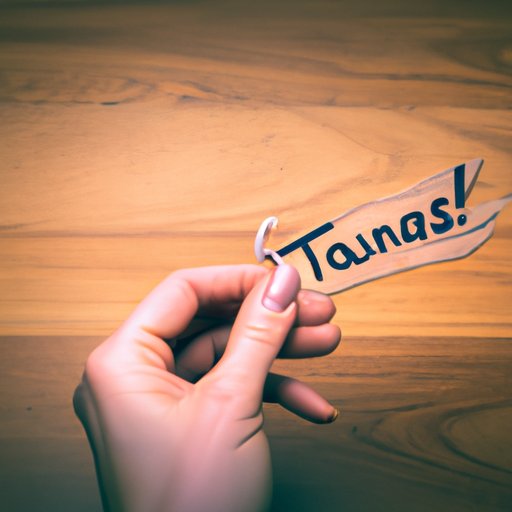
I. Introduction
For non-native speakers, expressing gratitude in a new language can be intimidating, especially when cultural nuances come into play. But fear not! In this article, we will provide helpful tips and strategies to confidently say thank you in Spanish, including common phrases, pronunciation, etiquette, and more.
II. Gracias: How to Confidently Say Thank You in Spanish
First and foremost, let’s start with the most common way of saying thank you in Spanish: “gracias”. Pronounced “GRA-see-as”, this word carries significant weight in Spanish culture and is used in a variety of contexts, from thanking the waiter at a restaurant to expressing gratitude towards a close friend.
When using “gracias”, it’s important to emphasize the first syllable and slightly raise your intonation towards the end, as if asking a question. This conveys sincerity and appreciation. You can also add modifiers such as “muchas” (meaning “many” or “a lot”) or “mil” (meaning “a thousand”) to amplify the impact of your gratitude. For example, “muchas gracias” or “mil gracias” can be used to express profound appreciation towards someone who has gone above and beyond.
III. Beyond Gracias: 5 Creative Ways to Say Thank You in Spanish
While “gracias” is a fantastic go-to phrase, there are other ways to express appreciation in Spanish that can add depth and nuance to your language skills. Here are five examples:
- “Te agradezco” – This phrase translates to “I thank you” and is slightly more formal and personalized than “gracias”.
- “De nada” – This phrase translates to “you’re welcome”, often used in response to someone thanking you.
- “Estoy agradecido” – This phrase translates to “I am grateful”, and can be used in more formal or professional contexts.
- “Gracias de antemano” – This phrase translates to “thank you in advance”, and can be used when asking someone for a favor or assistance.
- “Me has salvado” – This phrase translates to “you have saved me”, and can be used to express extreme gratitude towards someone who has helped you in a dire situation.
It’s important to note that the level of formality changes depending on the context and relationship between you and the person you’re thanking. For example, “te agradezco” is more appropriate when thanking a colleague or superior, while “mil gracias” would be more fitting when thanking a close friend or family member.
IV. Mastering Spanish Courtesy: A Step-by-Step Guide to Saying Thank You
To truly master the art of saying thank you in Spanish, it’s important to take a more comprehensive approach. Here’s a step-by-step guide:
- Step 1: Listen and Repeat – Start by listening to native speakers and repeating their phrases out loud. This will help you get a feel for the intonation, rhythm, and pronunciation of Spanish.
- Step 2: Learn Vocab – Study common phrases and vocabulary related to saying thank you. Use flashcards, apps, or other resources to help you memorize and retain the information.
- Step 3: Practice, Practice, Practice – Use what you’ve learned in real-life situations. Try ordering food at a restaurant or asking a stranger for directions, and incorporate thank-you phrases into your interactions.
- Step 4: Get Feedback – Ask native speakers for feedback on your pronunciation and language usage. This will help you fine-tune your skills and sound more natural.
- Step 5: Immerse Yourself – Immerse yourself in Spanish-language media such as music, TV shows, movies, and podcasts. This will help you become more comfortable with the language and understand cultural nuances.
V. The Dos and Don’ts of Saying Thank You in Spanish
When it comes to saying thank you in Spanish, there are a few cultural nuances and etiquette rules to keep in mind. Here are some dos and don’ts:
- DO use formal language in professional or formal settings, such as with colleagues, clients, or superiors.
- DON’T overuse “gracias” in casual settings with friends or family members. Instead, opt for more colloquial expressions such as “vale” (meaning “okay”) or “genial” (meaning “great”).
- DO adjust your tone and body language to convey sincerity and gratitude, such as making eye contact, smiling, or nodding.
- DON’T forget to say “de nada” (meaning “you’re welcome”) when someone thanks you.
- DO use additional phrases such as “por favor” (meaning “please”) and “disculpa” (meaning “excuse me”) to show respect and politeness.
VI. Saying Thank You in Spanish: A Beginner’s Guide to Essential Phrases and Vocabulary
If you’re just starting out with Spanish and want to learn basic phrases and vocabulary related to thanking others, here are some essential words and expressions:
- “Gracias” – meaning “thank you”
- “De nada” – meaning “you’re welcome”
- “Te agradezco” – meaning “I thank you”
- “Mil gracias” – meaning “a thousand thanks”
- “Por favor” – meaning “please”
Practice using these phrases in everyday situations such as ordering food, shopping, or greeting someone politely. As you become more comfortable with these basic phrases, you can gradually incorporate more nuanced expressions and advanced vocabulary.
VII. Conclusion
Learning how to say thank you in Spanish is a valuable skill, both for personal and professional interactions. By following the tips and strategies outlined in this article, you can build your confidence and fluency in expressing gratitude in Spanish. And remember, like any language skill, practice makes perfect!
Additional resources for learning Spanish include language learning apps like Duolingo and Rosetta Stone, online courses, Spanish-language media outlets such as Univision and Telemundo, and language exchange programs like HelloTalk.




